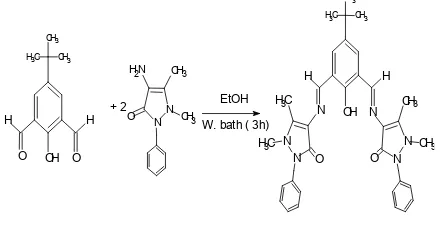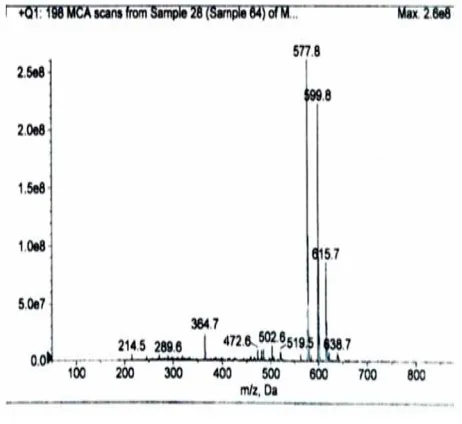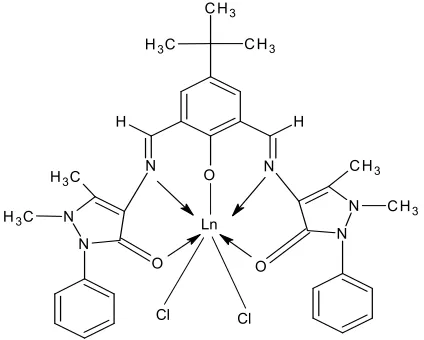Published online December 10, 2013 (http://www.sciencepublishinggroup.com/j/ajac) doi: 10.11648/j.ajac.20130105.12
Pentadentate
N
2
O
3
Schiff base complexes of rare earth
metals
Khalil Khalaf Abid
Department of Chemistry, College of Science, Al – Mustansiryah University 10052 Baghdad – Iraq
Email address:
drkhalil56@yahoo.com
To cite this article:
Khalil Khalaf Abid. Pentadentate N2O3 Schiff Base Complexes of Rare Earth Metals. American Journal of Applied Chemistry. Vol. 1, No. 5, 2013, pp. 87-91. doi: 10.11648/j.ajac.20130105.12
Abstract:
Acyclic Schiff base ligand containing N2O3 donor atoms was synthesized by the reaction of 2,6 – diformyl – 4– ter-butylphenol and 4 – aminoantipyrine in 1:2 molar ratio. The synthesized ligand (H1L) and Ln(III) complexes [Ln=
LaIII, CeIII and GdIII] were characterized by1HN.M.R., 13CN.M.R., mass spectrometry, UV /Visible, FTIR, Elemental analysis (C.H.N.), Magnetic susceptibility and Molar conductivity measurements. A seven coordinated complex obtained through N2O3 and two chloride atoms coordinated to metal ions.
Keyword:
Lanthanides, Schiff Bases, 2, 6-Diformyl Phenol, Pentadentate Acyclic Ligand1. Introduction
Schiff bases can be considered as a very important class of organic compounds due to their ability to form stable complexes with wide range of transition and rare-earth metal ions in different oxidation states via N and O atoms. They have the potential to be used in many areas such as electrochemistry, bioinorganic, catalysis, metallic deactivators, separation processes, and environmental chemistry. They are becoming important materials in the pharmacological, dye, plastic industries as well as in the field of liquid crystal technology1 – 5.
Transition and lanthanide metal complexes derived from Schiff-base ligands play a major role in the development of modern coordination chemistry providing examples of acyclic and macrocyclic ligand systems and the effects of steric interactions on coordination geometries. The chemistry of metal complexes with heterocyclic compounds containing nitrogen, sulfur, and/or oxygen as ligand atoms has attracted increasing attention. Compounds showing photoactivated cytotoxicity are of considerable importance for their selectivity in killing cancerous cells over the normal cells. When compared to the 3d–5d metal complexes, there are only few reports on the lanthanide complexes showing photoinduced biological activity and there is considerable scope to expand the chemistry of photocytotoxic lanthanide complexes6.
It is well known that the heterocyclic compounds exhibit bactericidal, fungicidal, herbicidal, and insecticidal
activities in addition to their application as potential drugs. Such heterocyclic ligands, when complexes with metal ions, exhibit enhanced microbiological activities. As an example, the activity of nickel is known because it is a component of a hydrolase (urease) and activates the genes of hydrogenases. Cerium is industrially important, used in nuclear reactors and in alloys with nickel and chromium in microwave devices. Cerium is also used in agriculture, forestry, and animal husbandry 7, 8
The chemistry of lanthanide complexes with Schiff bases has received little attention compared with the d block metal complexes. Recently, there has been a growing interest in the lanthanide–Schiff base complexes owing to the important applications of both metals and ligands. It can be used for the determination of some trace metals by liquid chromatography 9.
88 Khalil Khalaf Abid: Pentadentate N2O3 Schiff base Complexes of Rare Earth Metals
Schiff-base ligands with N, O donor sets have often been used since the Schiff-base ligands may assemble coordination architectures directed by the lanthanide (III) ions14, 15.
Since we had found that transition metal complexes with the ligands derived from 2,6 – diformyl-4-substituted phenols were dinuclear, as the ligand has five potential donor atoms (two carbonyl oxygens, two azomethine nitrogens and one phenolic oxygen)16. Binuclear complex obtained through phenolic oxygen acting as a bridge between two metal ions, as the ligand behaves as hexadentate type.
This study deals with synthesis and characterization, of lanthanide (III) complexes of this ligand. In this study a mono nuclear lanthanide complexes with seven coordination number as the ligand behaves as pentadentate donor atom (N2O3) with two chloride ion coordinated to
lanthanide ion.
2. Materials and Methods
All chemicals were analytical grade supplied from BDH and Fluka and used without any modification. Elemental analysis for the ligand and metal complexes were carried out using CHNS – elemental analyser at University of Al Albait, Amman, Jordan. 1H and 13CNMR spectra using Bruker 500MHz and DMSO as a solvent. Mass spectra using Electro Spray Ionization Mass Spectrometry at Jordanian University. Electronic spectra using Varian UV– visible spectrophotometer, Molar conductivity measurements using WTWF56 apparatus and DMSO as a solvent at Mustanseriyah University, Magnetic susceptibility measurements were carried out using Faraday method with balance magnetic susceptibility model MSB – MKI at Al – Nahrain University and FTIR using Shimadzu spectrophotometer and IR uses Pye – Unicam with CsI disc in Ibn – Sina Company, Baghdad,Iraq.
3. Experimental
3 – 1 Preparation of ligand: 4 – tert-But-2,6-diformylphenolbis(4-aminoantipyrine)(H1L): The ligand was prepared according to our previous paper17 ; (0.4g, 2 mmol) of 2,6 – diformyl – 4 – ter-butylphenol dissolved in ethanol (10 ml) was added slowly with stirring to( 0.80g, 4 mmol) of 4 – amino antipyrine dissolved in ethanol (20 ml). The resulting mixture was stirred under reflux on water bath for 3 hrs and the yellow precipitate was filtered, dried and then recrys tallized from ethanol to afford bright yellow crystals with 90% yield (scheme 1). Elemental analysis data; Found (calculated); %C,70.73 (70.51); %H6.25 (6.16) %N 14.56 (14.39).
3 – 2 Preparation of complexes: The metal complexes of [LaIII, CeIII and GdIII] were prepared by reaction of metal chloride dissolved in ethanol (20 ml) and H1L dissolved in ethanol (20 ml) with 1:1 molar ratio, by stirring under reflux for 7 hrs then reduced the volume by evaporation,
cooled and left aside for overnight. Fine powder obtained, filtered and recrystalized from ethanol to afford the appropriate precipitate (table1).
OH CH3 C H3 CH3 O O
H H NN
N H2 CH3
CH3
O
EtOH
+ 2 OH
CH3 C H3 CH3 N N H H N N C H3 O C
H3 N
N CH3
CH3
O W. bath ( 3h)
Scheme 1. synthesis of the ligand L1H
Table 1. some physical properties of ligand(L1H) and lanthanide
complexes
Yield% m.p.(oC)
Color Chemical formula 90 263 -265 Light orange
C34H36N6O3
60 >300
Off white [LaL1Cl
2]
53 >300
Pale yellow [CeL1Cl2]
45 >300
Orange [GdL1Cl
2]
4. Results and Discussion
4 –11HN.M.R. and 13CN.M.R. spectroscopy: Using d6 –
DMSO, only one compound recorded in 1HNMR spectroscopy belonging to the ligand, 13CN.M.R. spectroscopy showed the exact numbers and locations of the carbon atoms. The locations and assignment of each peak as follows (values in δppm): for 1HN.M.R.; 1.328 (– CH3)3, 2.453 [2(CH3-C )], 3.205 [2(CH3-N)],
7.382-7.835(Ar-H), 9.866[2(H- C=N)], 13.866 OH; for
13
CN.M.R.; 10.34 C (5,5- ), 31.63 C (1,2,3), 34.82 C (4), 35.74 C (6,6-), 115.79-134.62 C (Ar), 141.62 C (7,7-), 151.56 C (8,8-), 154.48 C (9), 157.82 C (10,10-), 159.80 C (11,11-). Due to the paramagnetic properties of CeIII and GdIII, only 1HN.M.R. spectra for LaIII complex was recorded using d6 – dmso as a solvent, which recorded the
disappearance of phenolic peak, while the other signals of the ligand were slightly shifted towards low field when compared to those of the free ligand, probably due to coordination effects of the metal ion ( see figure 1).
4 – 2 Infra – red spectra: For the prepared ligand (H1L) a
new band for C=N with the disappearance of two band for NH2 of the 4 – aminoantipyrine were recorded due to the
suffered a great download shift (20 – 25 cm coordination of phenolic oxygen with metal ions
Figure 1.1HN.M.R. spectrum of H
Table 2. Major Infra – red spectra of ligand (L1H) and complexes (cm
Compound ν(C=O) ν(C=N) ν(C-O)
C34H36N6O3 (L1H) 1658 1628 1296
[LaL1Cl
2] 1654 1617 1272 [CeL1Cl
2] 1649 1623 1276 [GdL1Cl2] 1651 1621 1274
4 – 3 Electronic spectra: The electronic spectra of lanthanide complexes were carried out using DMSO as a solvent and concentration of 10-3M. The ligand showed two strong bands at 267 and 332nm attributed to
transition of aromatic C = C and C = N, while the inter charge transfer band (INCT) of phenoxide group appeared at 388nm22. Ce(III) compounds are colorless, since the metal-centered f – d transition gives rise to an absorption in the near UV region and it combine with
band23. GdIII ion had half filled (f7) so absorptions are not observed since they are apparently too weak and no bands found in the visible region.
25 cm-1) suggest the coordination of phenolic oxygen with metal ions19 – 21.
HN.M.R. spectrum of H1L
H) and complexes (cm-1)
ν(M-N) ν(M-O) νM-Cl
- - -
481 447 310
473 424 328
477 430 312
The electronic spectra of lanthanide complexes were carried out using DMSO as a The ligand showed two strong bands at 267 and 332nm attributed to π → π* atic C = C and C = N, while the inter charge transfer band (INCT) of phenoxide group appeared Ce(III) compounds are colorless, since the d transition gives rise to an absorption in and it combine with charge transfer ) so absorptions are not observed since they are apparently too weak and no bands
4 – 4 Mass spectra: By using Mass Spectra (ESIMS) technique, the p
was recorded which agree with the suggested molecule formula (C34H36N6O3) ESIMS (+) m/z 615.7[M+K]
599.8[M+Na]+, 577.8 [M+H]
able to get mass spectra for the lanthanide complexes possibly because they were not volatile even at high temperatures.
Figure 2. mass spectrum of H
4 – 5 Magnetic measurements:
for the complexes was recorded in the solid state at 298 K using Gouey method in emu/mole units.
except Lu, have unpaired f electrons Landè Calculation for Ln+3 1- La+3 = 4f0, 1S0, µJ=0 B.M.
2- Ce+3= 4f1, S= , L=3, J=L-S = 3
gJ= +
PJ=gJ
3- Gd+3= 4f7, S= , L=0, J=L+S = 0+
gJ= +
/ =2PJ=gJ
However the magnetic moments from the spin-only values
coupling (Table 3). Magnetic moment of
recorded for CeIII complex due to the presence of one electron. In GdIII complex a magnetic moment of
was recorded which suggest a
unpaired electrons is 7, with all the electrons have parallel spin. This property is important for the use of
complexes as contrast reagent
4 – 6Molar conductivity measurements:
By using Electro Spray Ionization technique, the parent ion P+ (576.68) was recorded which agree with the suggested molecule ) ESIMS (+) m/z 615.7[M+K]+ , , 577.8 [M+H]+ ( see figure 2).We were not able to get mass spectra for the lanthanide complexes were not volatile even at high
mass spectrum of H1L
Magnetic measurements: Magnetic suscep- tibility for the complexes was recorded in the solid state at 298 K using Gouey method in emu/mole units. All the Ln(III) ions,
, have unpaired f electrons .
+3
ions: → 1S0
S = 3- = → 2F 5/2
/ =0.857
1 =2.53 B.M.
, L=0, J=L+S = 0+ = → 8S7/2
=2PJ=gJ 1 =7.94 B.M.
However the magnetic moments deviate considerably because of strong spin-orbit agnetic moment of 2.17B.M. was recorded for CeIII complex due to the presence of one In GdIII complex a magnetic moment of 8.11 B.M was recorded which suggest a maximum number of unpaired electrons is 7, with all the electrons have parallel spin. This property is important for the use of gadolinium
agent in MRI scans24, 25.
90 Khalil Khalaf Abid: Pentadentate N2O3 Schiff base Complexes of Rare Earth Metals
solvent and a concentration of 10-3M, all complexes showed a behavior of non electrolyte type indicating the presence of two chloride ions inside the coordination
sphere, and these results agree with the suggested configurations of the lanthanide complexes (Table 3).
Table 3. Molar conductivity and magnetic moment data of Ln(III) complexes.
Complexes eff B.M eff Van Vleck B.M.
Molar conductance
(ΩΩΩΩ-1cm2mol-1) Geometry
[LaL1Cl
2] 0.0 X=−0.15×10-6 cm g sec 11.91 Mcoh*. (C.N=7)
[CeL1Cl2] 2.17 2.54 12.50 Mcoh*. (C.N=7)
[GdL1Cl
2] 8.11 7.94 10.3 Mcoh*. (C.N=7)
* Mcoh=Monocapped octahedron
5. Conclusion
An acyclic Schiff base ligand containing N2O3 donor
atoms and its mono nuclear lanthanide complexes were prepared. The analytical data observed suggested complexes with seven coordination number as the ligand behaves as pentadentate donor atoms with two chloride ions coordinated to lanthanide ion (figure 3).
N
.
N
H H
N
N N
N
C H3
C
H3
C H3
C H3
C
H3
O O
C
H3
C H3
O
Ln
Cl Cl
Figure 3. Ln: LaIII, CeIII, GdIII
Acknowledgment
The author would like to thank the University of Al Albait, Amman, Jordan for spectral data and Al-Mustansiriyah University, College of Science for providing the financial support.
References
[1] K. K. Narang, T. R. Raob, S. Sesthab and S. Shrestha; Synth. React. Inorg. Met.- Org.Chem, 30(5), 931(2000).
[2] Tahaa Z. A., Ajlounia A. M., Al- Hassanb K. A., Hijazi A. K. and Faiqa A. B.; Spectrochimica Acta, Part A 81, 317(2011) [3] Singh B. and Singh T. B.; Synth. React. Inorg. Met-Org.
Chem., 33, No. 4, 639 (2003)
[4] A. A. Al-Ameiry; (2012) Res Chem. Intermed. DOI0.1007/s11164-011-0414-8
[5] K. K. Abid and B. F. Abbas ; (2012) Res Chem Intermed, DOI 10.1007/s11164- 012-0914-1
[6] Z. H. Abd el-whab; Journal of Coordination Chemistry, 61, No. 20, 3284 (2008).
[7] A. Hussain and A. R. Chakravarty; J. Chem. Sci., 124, No. 6, 1327 (2012)
[8] P. Kapoor, R. V. Singh and N. Fahmi; Journal of Coordination Chemistry, 65, No. 2, 262 (2012).
[9] A. S. Ramasubramanian, B. B. Ramachandra and R. Dileep; Synth. React. Inorg. Met-Org. Nano-Met. Chem., 42, 548 (2012).
[10] R. C. Palenik, K. A. Abboud, S. P. Summers, L. L. Reitfort and G. J. Palenik; Inorganica Chimica Acta, 359, 4645 (2006).
[11] T. Arslan, C. O. G. Retiry, M. Tsiouri, J. C. Plakatouras and N. Hadjiliadis; Journal of Coordination Chemistry, 60, No. 6, 699 (2007).
[12] M. T. Kaczmarek, I. Pospieszna-Markiewicz, M. Kubicki and W. Radecka-Paryzek; Inorg. Chemical Communication, 7, 1247 (2004).
[13] M. G. B. Drew, M. R. Foreman, M. J. Hudson and K. F. Kennedy; Inorg. Chim. Acta , 57, 4102 (2004).
[14] P. A. Vigato and S. Tamburin; Coordination Chemical Review, 248, 717(2004).
[15] C. Benelli and D. Gatteschi; Chemical Review (2002) 102, 2369.
[16] M. Tsiouri, J. C. Plakatouras, A. Garoufis, V. Nastopoulos and N. Hadjiliadis; Inorganic Chemistry Communications, 5, 844 (2002).
[17] K. K. Abid and A. B. Omar; (2013) Res. Chem. Intermed., DOI 10.1007/s 11164-013-1306-x
[18] S. K. Agarwal and J. P. Tandon; Monatsh. Chemistry, 110, 401 (1979).
[19] B. H. M. Mruthyunjayaswamy, B. Ijare and Y. Jadegoud; J. Braz. Chemical Soc., 16 (4)738 (2005).
[20] M. S. Annigeri, M. P. Sathisha and V. K. Revankar; Transition Metal Chem., 32, 81 (2007).
[22] S. J. Archibald, A. J. Blake, M. Schroder and R. E. P. Winpenny; J. Chemical Soc. Chemical Communication, 1669 (1994).
[23] T. Szczurek and M. Schlesinger; Rare Earth Spectroscopy” World Scientific, Singapore, P309 (1985)
[24] M. H. V. Werts; Science Progress, 88, 101 (2005) .


